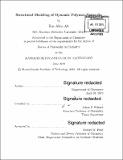Structural modeling of dynamic polymer networks
Author(s)
Alt, Eric Allen.
Download1123218287-MIT.pdf (14.60Mb)
Other Contributors
Massachusetts Institute of Technology. Department of Chemistry.
Advisor
Adam P. Willard.
Terms of use
Metadata
Show full item recordAbstract
Polymer network based gels are an important class of materials with a wide range of applications. Dynamic polymer networks, which crosslink via the formation of reversible bonds, in particular have great potential as stimuli responsive, mechanically tunable, and self-healing materials. Many important emergent properties of these materials, such as mechanical strength, are mediated by their underlying network structure, which can be characterized by the network topology and spatial distribution of nodes. Therefore, unlocking the full potential of these materials through rational design requires an understanding of how network structure arises as a function of network-forming precursor design. Because the bonds that crosslink dynamic polymer networks are reversible, stresses initially present or otherwise induced in these systems can be relieved through network rearrangement. As such, given sufficient time to relax, the network structure is determined by equilibrium thermodynamics. This work presents a thermodynamic formalism which characterizes the free energy of a network in terms of node positional, network topological, and polymer conformational entropies. Through this lens, and aided by numerical calculations and simulations of model networks, we show how the free energy landscape with respect to density relates to factors which can be readily controlled through precursor design, such as polymer length and node size. Additionally, Monte Carlo simulations of explicit networks reveal that thermodynamic relaxation can give rise to spatial heterogeneity in the arrangement of network nodes. In the last chapter we use the tools developed in the earlier chapters to explore how these same design parameters influence the topological statistics of equilibrium networks. In addition to showing how internode connectivity increases with polymer length and system density, we find that inhomogeneity due to spatial relaxation can also lead to greater network connectivity. Finally, we explore the weakening of network topologies due to substitution of polymer-linked node forming components with topologically non-functional counterparts, finding that larger nodes fare better than their smaller counterparts in maintaining network connectivity when these substitutions are made.
Description
Thesis: Ph. D., Massachusetts Institute of Technology, Department of Chemistry, 2019 Cataloged from PDF version of thesis. Includes bibliographical references (pages 125-131).
Date issued
2019Department
Massachusetts Institute of Technology. Department of ChemistryPublisher
Massachusetts Institute of Technology
Keywords
Chemistry.